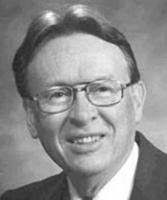










Howard Tracy Hall, an inventor who in 1954 was a key part of a pioneering scientific team at General Electric that made the first synthetic diamonds, died on July 25 in Provo, Utah. He was 88.
Research Career
At the Research Laboratory of G.E. in Schenectady, N.Y., Dr. Hall and his team used a powerful hydraulic press to subject carbon to extreme pressures and create a sample of tiny octahedral diamonds. In the process, the scientists had also heated the carbon to about 5,000 degrees Fahrenheit and reconfigured its molecular structure.
The result, which was later successfully repeated, was the fruit of three years of experimentation and several centuries of speculation. Since the 19th century, others, including the British engineer Sir Charles Parsons, had tried and failed to reproduce the deep Earth’s pressures and thereby force carbon into the diamond’s crystalline structure. Dr. Hall improved the press’s compression and operation. He said his knees buckled when he realized that the experiment, called Project Superpressure, was a success.
In the 1960s, the oil, aerospace and stone-quarrying industries rapidly recognized the importance of synthetic diamonds, and they continue to use them in making drill bits, grinding machines, saw blades and cutting wires.
In comparison with naturally produced diamonds, synthetics are in ready supply and, because of their uniform size, “allow us to tailor the diamond crystal to the application, which represents a brilliant advance,” said Terry M. Kane, executive director of the diamond association, in Columbus, Ohio.
With his colleagues Herbert M. Strong and Robert H. Wentorf Jr., Dr. Hall, a physical chemist, was granted a patent in 1960 for their novel method of making diamonds. Further credit for Project Superpressure was shared broadly with Francis P. Bundy, James E. Cheney and other team members.
Dr. Hall left G.E. and moved to Brigham Young University, where he taught chemistry. He later developed a more efficient hydraulic press, called a tetrahedral press, and received a patent for it. Similar high-pressure systems have since been employed to make larger diamonds for jewelry and other purposes.
In 1966, Dr. Hall helped to found MegaDiamond, a Provo company that makes industrial diamonds. He also helped establish Novatek International, a company that manufactures diamond-tipped drill bits and other products.
Howard Tracy Hall was born on Oct. 20, 1919, in Ogden, Utah. He earned a doctorate in chemistry from the University of Utah in 1948.
In 1977, the American Physical Society honored him for his studies in synthetic diamonds and another ultrahard material, cubic boron nitride.
In the 1980s, Dr. Hall, who became a bishop in the Church of Jesus Christ of Latter-day Saints, went on a church mission to Africa with his wife, the former Ida-Rose Langford. She died in 2005.
He is survived by seven children, 35 grandchildren and 53 great-grandchildren.
Death
Dr. Hall’s death was confirmed by a spokesman for the Industrial Diamond Association of America, a trade organization.